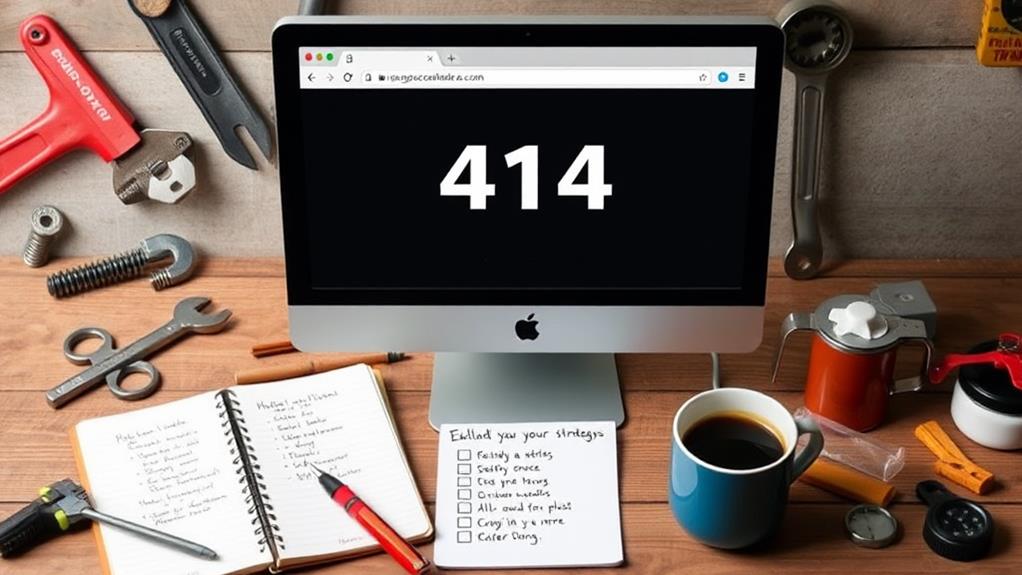To fix the 414 Request URI Too Large error, start by identifying the cause. This usually happens when your URL is too long, often from too many query parameters. Use POST requests for larger data instead of GET requests. You can also adjust your server settings; for Apache, increase the 'LimitRequestLine' to a maximum of 128,000 characters. If you're on Nginx, modify 'large_client_header_buffers'. Consider simplifying your URLs or using URL rewriting techniques to keep them short. There's more to explore about enhancing your server configuration and preventing future errors.
Understanding the 414 Error
Understanding the 414 error starts with recognizing that it occurs when the request URI sent to the server exceeds its processing limits. This HTTP status indicates that the URL length has become too long, often due to excessive query parameters in a GET request.
Different servers have varying default limits for URI length; for example, Apache Servers typically have a default limit set at 8190 characters, which can be adjusted using the 'LimitRequestLine' directive. If your WordPress installation encounters issues, it's essential to guarantee that sufficient memory allocation is set to handle larger requests effectively.
On the client side, browsers also impose their own URI length restrictions, with Internet Explorer capping URLs at 2083 characters while Chrome allows up to 2MB.
You might encounter a 414 error during redirect loops or when large sets of data are passed as URL parameters, resulting in excessively long request URIs. To avoid this issue, it's wise to reconsider your data submission methods.
Using POST requests for larger data payloads can help mitigate the risk of hitting these limits, reducing the chances of triggering a 414 error in the first place. By understanding these aspects, you can better manage your web interactions and server configurations.
Common Causes of the Error
Numerous factors can trigger the 414 Request URI Too Large error, primarily stemming from excessively long URLs filled with numerous or lengthy query parameters. Here are three common causes:
1. Server Configurations: Many servers, like Apache, have a default 'LimitRequestLine' setting of 8190 characters, which restricts the maximum allowed URI length. If your URL exceeds this limit, you'll encounter the 414 error.
Additionally, using outdated themes and plugins can exacerbate server issues, as they may lead to inefficient URL handling, making it essential to keep them updated to avoid vulnerabilities of themes and plugins.
2. Client-Side Limitations: Different web browsers impose their own restrictions on URL lengths. For instance, Internet Explorer has a maximum URL length of 2083 characters, while Chrome allows up to 2MB. If your long URL surpasses these limits, it can trigger the error.
3. Dynamic Content Generation: Websites that dynamically generate content often create long URLs. When passing large sets of data or identifiers as query parameters, it can lead to exceeding the allowed URI length, resulting in the error.
Additionally, improper HTTP method usage, such as converting a POST request to a GET with substantial parameters, can also contribute to the issue.
Understanding these causes can help you identify the root of the 414 error.
Effective Fixing Strategies

Addressing the 414 Request URI Too Large error requires a combination of strategic adjustments and best practices.
First, consider using a POST request instead of GET for data submissions. Unlike GET, POST allows for larger payloads and keeps data out of the URI, reducing the chance of hitting length limits.
Additionally, implementing strong passwords and security measures like Multi-Factor Authentication (MFA) can enhance overall security, helping to prevent unauthorized access that could lead to excessively long URLs.
Next, review your query parameters; excessively long URLs often stem from having too many parameters. Streamlining these can make a significant difference.
Another effective strategy is to implement URL rewriting techniques. This allows you to create shorter, more static URLs that help mitigate the issue.
Additionally, regularly validating and sanitizing input data is vital, as it prevents the generation of excessively long URLs that can trigger the error.
Server Configuration Adjustments
Server configuration adjustments play an essential role in resolving the 414 Request URI Too Large error. By tweaking specific settings in your server configuration, you can effectively handle larger URIs without encountering this frustrating error code.
Implementing these adjustments not only helps in addressing the error but also contributes to overall website security best practices. Here are three key adjustments you might consider:
- Apache Servers: Modify the 'LimitRequestLine' directive in your configuration file to increase the maximum length of the URI. A common recommendation is to set it around 128,000 characters.
- Nginx Servers: Adjust the 'large_client_header_buffers' setting to allow more extensive headers. Recommended buffer sizes range from 8K to 128K, typically in multiples of two for peak performance.
- Plan for Downtime: When you make these server settings changes, remember that a restart of the web server is often necessary for them to take effect. Always back up your configuration files before making adjustments to prevent data loss or misconfiguration.
Regularly reviewing and adjusting these limits based on your application needs can help balance performance with security, ensuring your server can handle requests without running into the dreaded URI too long error.
Additional Resources and Best Practices

When you're dealing with the 414 Request URI Too Large error, it's essential to arm yourself with the right resources and best practices to prevent it from happening again. Start by ensuring your URLs are concise. Utilize URL rewriting techniques to create shorter, more manageable static URLs to help avoid exceeding limits.
Implementing secure file upload practices can also enhance your site's overall security, which is critical for maintaining user trust and preventing data breaches secure file upload solutions.
Keep your URLs under 2000 characters, as many browsers have strict limits—like Internet Explorer at 2083 characters and Chrome at 2048 characters. When you're submitting large data sets, prefer using POST requests instead of GET requests. This helps you avoid exceeding URI length limits and keeps your data separate from the URL.
Regularly review your application's query parameters to minimize their size and complexity. This proactive step reduces the risk of triggering a 414 error.
Finally, document any server configuration changes you make to accommodate longer URIs. This documentation will help inform future adjustments and troubleshooting efforts, ensuring you understand the impact of your configuration decisions.
Conclusion
To conclude, tackling the 414 Request-URI Too Large error doesn't have to be a headache. By understanding its causes and implementing the right strategies, you can get your server back on track in no time. Remember, it's better to nip this issue in the bud before it snowballs into bigger problems. Keep your configurations in check, and don't hesitate to consult additional resources. With these steps, you'll be well on your way to smoother web operations!



